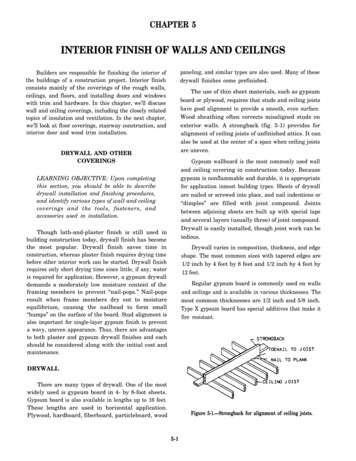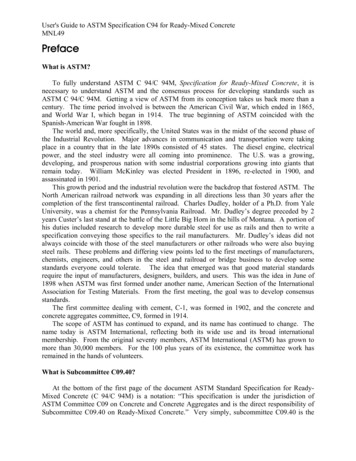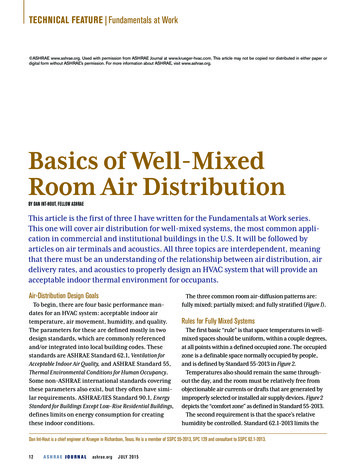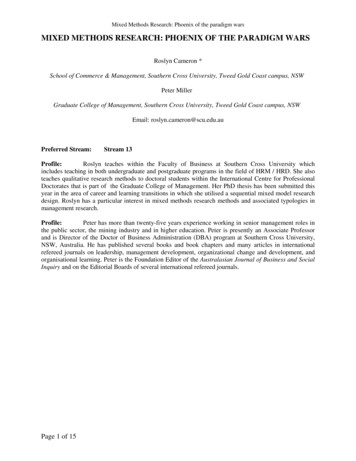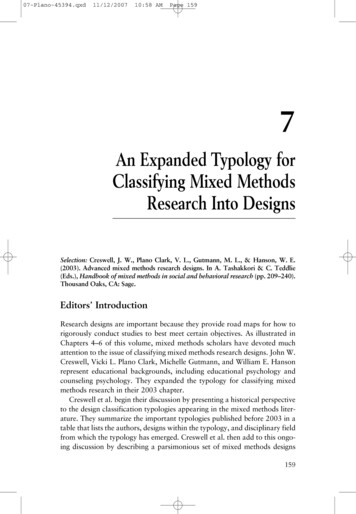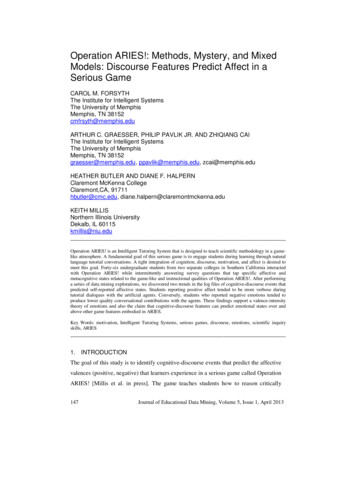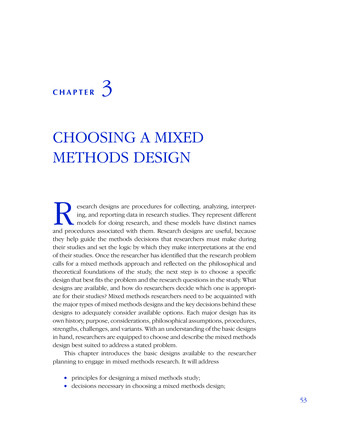
Transcription
CHAPTER3CHOOSING A MIXEDMETHODS DESIGNResearch designs are procedures for collecting, analyzing, interpreting, and reporting data in research studies. They represent differentmodels for doing research, and these models have distinct namesand procedures associated with them. Research designs are useful, becausethey help guide the methods decisions that researchers must make duringtheir studies and set the logic by which they make interpretations at the endof their studies. Once the researcher has identified that the research problemcalls for a mixed methods approach and reflected on the philosophical andtheoretical foundations of the study, the next step is to choose a specificdesign that best fits the problem and the research questions in the study. Whatdesigns are available, and how do researchers decide which one is appropriate for their studies? Mixed methods researchers need to be acquainted withthe major types of mixed methods designs and the key decisions behind thesedesigns to adequately consider available options. Each major design has itsown history, purpose, considerations, philosophical assumptions, procedures,strengths, challenges, and variants. With an understanding of the basic designsin hand, researchers are equipped to choose and describe the mixed methodsdesign best suited to address a stated problem.This chapter introduces the basic designs available to the researcherplanning to engage in mixed methods research. It will address principles for designing a mixed methods study; decisions necessary in choosing a mixed methods design;53
54 DESIGNING AND CONDUCTING MIXED METHODS RESEARCH characteristics of major mixed methods designs; the history, purpose, philosophical assumptions, procedures,strengths, challenges, and variants for each of the major designs; and a model for writing about a design in a written report. PRINCIPLES FOR DESIGNING A MIXED METHODS STUDYDesigning research studies is a challenging process in both quantitativeand qualitative research. This process can become even more of a challenge when the researcher has decided to use a mixed methods approachdue to the inherent complexity in mixed methods designs. Although thedesign and conduct of any two mixed methods studies will never beexactly alike, there are several key principles that researchers consider tohelp navigate this process: using a fixed and/or emergent design; identifying a design approach to use; matching a design to the study’s problem,purpose, and questions; and being explicit about the reason for mixingmethods.Recognize That Mixed MethodsDesigns Can Be Fixed and/or EmergentMixed methods designs may be fixed and/or emergent, and researchersneed to be cognizant of the approach that they are using and open to considering the best alternative for their circumstances. Fixed mixed methodsdesigns are mixed methods studies where the use of quantitative and qualitative methods is predetermined and planned at the start of the researchprocess, and the procedures are implemented as planned. Emergentmixed methods designs are found in mixed methods studies where theuse of mixed methods arises due to issues that develop during the processof conducting the research. Emergent mixed methods designs generallyoccur when a second approach (quantitative or qualitative) is added afterthe study is underway because one method is found to be inadequate(Morse & Niehaus, 2009). For example, Ras (2009) described how shefound the need to add a quantitative component to her qualitative casestudy of self-imposed curricular change at one elementary school. Sheaddressed emergent concerns with the trustworthiness of her interpretations of what she learned from her participants. In this way, her qualitativecase study became a mixed methods study during her process of implementing the research study.
Chapter 3. Choosing a Mixed Methods DesignWe view these two categories—fixed and emergent—not as a cleardichotomy but as end points along a continuum. Many mixed methodsdesigns actually fall somewhere in the middle with both fixed and emergentaspects to the design. For example, the researcher may plan to conduct astudy in two phases from the start, such as beginning with a quantitativephase and then following up with a qualitative phase. The details of thedesign of the second, qualitative phase, however, may emerge based on theresearcher’s interpretation of the results from the initial quantitative phase.Therefore, the study becomes an example of combining both fixed and emergent elements.Due to our focus on planning mixed methods studies and the linear andfixed nature of printed text, our writing may appear to emphasize fixeddesigns. Keep in mind, however, that we recognize the importance andvalue of emergent mixed methods approaches. We believe that most of thedesign elements that we address in this book apply well whether the use ofmixed methods is planned from the start and/or emerges due to the needsof a study.Identify an Approach to DesignIn addition to using fixed and emergent mixed methods designs, researchersalso use different approaches for designing their mixed methods studies.There are several approaches to design that have been discussed in the literature, and researchers can benefit from considering their personal approachto designing mixed methods studies. These design approaches fall into twocategories: typology-based and dynamic.A typology-based approach to mixed methods design emphasizes theclassification of useful mixed methods designs and the selection and adaptation of a particular design to a study’s purpose and questions. Unquestionably,this design approach has been discussed most extensively in the mixed methods literature, as shown by the amount of effort that has been spent on classifying mixed methods designs. There is a wide range of availableclassifications of types of mixed methods designs that methodologists haveadvanced. Creswell, Plano Clark, Gutmann, and Hanson (2003) summarizedthe range of these classifications in 2003, and we have updated the summarywith a list of 15 classifications in Table 3.1. These classifications representdiverse disciplines, including evaluation, health sciences, and education, andspan scholarly writings about mixed methods approaches since the late1980s. They also tend to use different terminology and emphasize differentfeatures of mixed methods designs (a topic we will turn our attention to later 55
56 DESIGNING AND CONDUCTING MIXED METHODS RESEARCHTable 3.1Mixed Methods Design ClassificationsAuthorDisciplineMixed Methods DesignsGreene,Caracelli, andGraham lementarityTriangulationPatton (1990)EvaluationExperimental design, qualitative data, and content analysisExperimental design, qualitative data, and statistical analysisNaturalistic inquiry, qualitative data, and statistical analysisNaturalistic inquiry, quantitative data, and statistical analysisMorse (1991)NursingSimultaneous triangulationSequential triangulationSteckler,McLeroy,Goodman, Bird,and McCormick(1992)Public healtheducationGreene andCaracelli (1997)EvaluationModel 1: Qualitative methods to develop quantitative measuresModel 2: Qualitative methods to explain quantitative findingsModel 3: Quantitative methods to embellish qualitative findingsModel 4: Qualitative and quantitative methods used equallyand parallelComponent ated designsIterativeEmbedded or nestedHolisticTransformativeMorgan (1998)HealthresearchComplementary designsQualitative preliminaryQuantitative preliminaryQualitative follow-upQuantitative follow-up
Chapter 3. Choosing a Mixed Methods DesignAuthorDisciplineMixed Methods DesignsTashakkori andTeddlie (1998)EducationalresearchMixed methods designs 57Equivalent status (sequential or parallel)Dominant–less dominant (sequential or parallel)Multilevel useMixed model designsI. Confirmatory, qualitative data, statistical analysis, andinferenceII. Confirmatory, qualitative data, qualitative analysis, andinferenceIII. Exploratory, quantitative data, statistical analysis, andinferenceIV. Exploratory, qualitative data, statistical analysis, andinferenceV. Confirmatory, quantitative data, qualitative analysis,and inferenceVI. Exploratory, quantitative data, qualitative analysis, andinferenceVII. Parallel mixed modelVIII. Sequential mixed modelCreswell (1999)EducationalpolicyConvergence modelSequential modelInstrument-building terativeSandwichCreswell, PlanoClark, Gutmann,and Hanson(2003)EducationalresearchSequential explanatorySequential exploratorySequential transformativeConcurrent triangulationConcurrent nestedConcurrent transformative(Continued)
58 DESIGNING AND CONDUCTING MIXED METHODS RESEARCHTable 3.1(Continued)AuthorDisciplineMixed Methods DesignsCreswell, Fetters,and Ivankova(2004)Primarymedical careInstrument design modelTashakkori andTeddlie (2003b)Social andbehavioralresearchTriangulation design modelData transformation design modelMultistrand designsConcurrent mixed designsConcurrent mixed methods designConcurrent mixed model designSequential mixed designsSequential mixed methods designSequential mixed model designMultistrand conversion mixed designsMultistrand conversion mixed methods designMultistrand conversion mixed model designFully integrated mixed model designGreene (2007)EvaluationComponent designsConvergenceExtensionIntegrated designsIterationBlendingNesting or embeddingMixing for reasons of substance or valuesTeddlie &Tashakkori(2009)EducationalresearchMixed methods multistrand designsParallel mixed designsSequential mixed designsConversion mixed designsMultilevel mixed designsFully integrated mixed designs
Chapter 3. Choosing a Mixed Methods DesignAuthorDisciplineMixed Methods DesignsMorse andNeihaus (2009)NursingMixed method simultaneous designs 59Mixed method sequential designsComplex mixed method designsQualitatively driven complex mixed method designQuantitatively driven complex mixed method designMultiple method research programSOURCE: Adapted from Creswell, Plano Clark, et al. (2003, pp. 216–217, Table 8.1) with permission of SAGEPublications, Inc.in this chapter). The different types and various classifications speak to theevolving nature of mixed methods research and the utility of consideringdesigns as a framework for thinking about mixed methods.There are also dynamic approaches for thinking about the process ofdesigning a mixed methods study. Dynamic approaches to mixed methodsdesign focus on a design process that considers and interrelates multiplecomponents of research design rather than placing emphasis on selecting anappropriate design from an existing typology. Maxwell and Loomis (2003)introduced an interactive, systems-based approach to mixed methodsdesign. They argued that the researcher should weigh five interconnectedcomponents when designing a mixed methods study: the study’s purposes,conceptual framework, research questions, methods, and validity considerations. Although research questions are at the heart of this process, they discuss how the interrelationships among the components need to beconsidered throughout the design process.Hall and Howard (2008) recently described another dynamic approachto mixed methods design, which they called the synergistic approach.They suggested that the synergistic approach provided a way to combinea typological approach with a systemic approach. In a synergisticapproach, two or more options interacted so that their combined effectwas greater than the sum of the individual parts. Translated into mixedmethods, this meant that the sum of quantitative and qualitative researchwas greater than either approach alone. They defined this approachthrough a set of core principles: the concept of synergy, the position ofequal value, the ideology of difference, and the relationship between the
60 DESIGNING AND CONDUCTING MIXED METHODS RESEARCHresearcher(s) and the study design. They argued that this approach provided an effective combination of structure and flexibility that helpedthem consider how epistemology, theory, methods, and analysis couldwork together within a mixed methods design.We suggest that researchers, particularly those new to designing andconducting mixed methods studies, consider starting with a typology-basedapproach to mixed methods design. Typologies provide the researcher witha range of available options to consider that are well defined, facilitate theresearcher’s use of a solid approach for addressing the research problem,and help the researcher anticipate and resolve challenging issues. That said,we do not advocate that researchers adopt a typology-based design like acookbook recipe but instead use it as a guiding framework to help informdesign choices. As researchers gain more expertise with mixing methods,they are more able to effectively design their studies using a dynamicapproach.Match the Design to the ResearchProblem, Purpose, and QuestionsThe different approaches for mixed methods design differ in their emphasesbut also share many commonalities. In particular, each emphasizes the overall problem, purpose, and research questions that are guiding the study.Research problems and questions that interest researchers arise in manyways, such as from the literature, the researcher’s experiences or values,logistical constraints, results that cannot be explained, and stakeholderexpectations (Plano Clark & Badiee, in press). No matter how the researchquestions are generated, scholars writing about mixed methods researchuniformly agree that the questions of interest play a central role in theprocess of designing any mixed methods study. The importance of theresearch problem and questions is a key principle of mixed methodsresearch design. This perspective stems from the pragmatic foundations forconducting mixed methods research where the notion of “what works”applies well to selecting the methods that “work” best to address a study’sproblem and questions.Recall the general research problems related to mixed methods introduced in Chapter 1. These included one data source alone is insufficient,results need to be explained, exploratory results need to be further examined,a study needs to be enhanced through adding a second method, a theoreticalstance needs to be advanced through the use of both types of methods, and
Chapter 3. Choosing a Mixed Methods Designa problem needs to be studied through multiple phases of research thatinclude multiple types of methods. Research problems like these not only callfor the use of mixed methods but also call for the researcher to use differentdesigns that are able to address the different types of problems. Therefore,researchers should articulate their research problem and questions and consider them carefully so as to choose a design that matches the problem andresearch questions. As we consider research questions in Chapter 5, we willalso discuss how some research questions may be stated or refined to reflectthe selected design.Be Explicit About the Reasons for Mixing MethodsAnother key principle of mixed methods design is to identify the reason(s)for mixing quantitative and qualitative methods within the study. Combiningmethods is challenging and should only be undertaken when there is a specific reason to do so. There are many good discussions of reasons for mixingmethods found in the literature to help researchers guide their work. Twoprominent frameworks are listed in Table 3.2. The first is the list of five broadreasons for mixing methods identified by Greene, Caracelli, and Graham intheir 1989 work. These reasons—triangulation, complementarity, development, initiation, and expansion—are defined in the table. Although theywere quite broad and general, this typology of reasons is still frequently usedand discussed in the literature. As mixed methods research has continued toevolve in the past 20 years, however, more detailed descriptions ofresearchers’ reasons have emerged. Recently, Bryman (2006) provided adetailed list of reasons based on researchers’ practices (see Table 3.2). His listof 16 reasons offered a useful, more detailed examination of researchers’ reasons and practices that added to the more general description found inGreene et al.’s (1989) work.Keep in mind that the reasons listed for mixing methods should beviewed as a general framework from which researchers can weigh alternative choices and use to justify their mixing decisions. In his work,Bryman (2006) noted that many mixed methods studies make use of multiple reasons for mixing methods and that new reasons for mixing mayemerge as the study is underway. Being responsive to new insights is anessential aspect of conducting mixed methods research, but we feel is italso important for researchers to design their mixed methods studieswith at least one clear reason as to why they are planning to combinemethods. 61
62 DESIGNING AND CONDUCTING MIXED METHODS RESEARCHTable 3.2Two Typologies of Reasons for Mixing MethodsGreene, Caracelli, and Graham (1989) 1Bryman (2006) 2 Triangulation seeks convergence,corroboration, and correspondence ofresults from the different methods. Complementarity seeks elaboration,enhancement, illustration, andclarification of the results from onemethod with the results from the othermethod. Development seeks to use the resultsfrom one method to help develop orinform the other method, wheredevelopment is broadly construed toinclude sampling and implementation,as well as measurement decisions. Initiation seeks the discovery ofparadox and contradiction, newperspectives of frameworks, therecasting of questions or results fromone method with questions or resultsfrom the other method. Expansion seeks to extend the breadthand range of inquiry by using differentmethods for different inquirycomponents. Triangulation or greater validity refers to thetraditional view that quantitative and qualitativeresearch might be combined to triangulate findingsin order that they may be mutually corroborated. Offset refers to the suggestion that the research methodsassociated with both quantitative and qualitativeresearch have their own strengths and weaknesses sothat combining them allows the researcher to offset theirweaknesses to draw on the strengths of both. Completeness refers to the notion that the researchercan bring together a more comprehensive account ofthe area of inquiry in which he or she is interested ifboth quantitative and qualitative research are employed. Process refers to when quantitative research providesan account of structures in social life but qualitativeresearch provides sense of process. Different research questions refers to the argumentthat quantitative and qualitative research can eachanswer different research questions. Explanation refers to when one is used to helpexplain findings generated by the other. Unexpected results refers to the suggestion thatquantitative and qualitative research can be fruitfullycombined when one generates surprising results thatcan be understood by employing the other. Instrument development refers to contexts in whichqualitative research is employed to developquestionnaire and scale items—for example, so thatbetter wording or more comprehensive closedanswers can be generated. Sampling refers to situations in which one approach isused to facilitate the sampling of respondents or cases. Credibility refers to suggestions that employing bothapproaches enhances the integrity of findings. Context refers to cases in which the combination isrationalized in terms of qualitative researchproviding contextual understanding coupled witheither generalizable, externally valid findings orbroad relationships among variables uncoveredthrough a survey.
Chapter 3. Choosing a Mixed Methods DesignGreene, Caracelli, and Graham (1989) 1 63Bryman (2006) 2 Illustration refers to the use of qualitative data toillustrate quantitative findings, often referred to as putting“meat on the bones” of “dry” quantitative findings. Utility or improving the usefulness of findings refersto a suggestion, which is more likely to be prominentamong articles with an applied focus, that combiningthe two approaches will be more useful topractitioners and others. Confirm and discover refers to using qualitative datato generate hypotheses and using quantitativeresearch to test them within a single project. Diversity of views includes two slightly differentrationales—namely, combining researchers’ andparticipants’ perspectives through quantitative andqualitative research respectively and uncoveringrelationships between variables through quantitativeresearch while also revealing meanings amongresearch participants through qualitative research. Enhancement or building upon quantitative andqualitative findings entails a reference to makingmore of or augmenting either quantitative orqualitative findings by gathering data using aqualitative or quantitative research approach.1Reprinted from Educational Evaluation and Policy Analysis, Vol. 11, Issue 3, p. 259, 1989, with permission of SAGEPublications, Inc.2Reprinted from Qualitative Research, Vol. 6, Issue 1, pp. 105–107, 2006, with permission of SAGE Publications, Inc.KEY DECISIONS IN CHOOSING A MIXED METHODS DESIGNBuilding on the four principles previously discussed, researchers are in a position to make important choices that define the mixed methods design used ina study. These decisions address the different ways that the quantitative andqualitative strands of the study relate to each other. A strand is a component ofa study that encompasses the basic process of conducting quantitative or qualitative research: posing a question, collecting data, analyzing data, and interpreting results based on that data (Teddlie & Tashakkori, 2009). Mixed methodsstudies meeting our definition of mixed methods research include at least onequantitative strand and one qualitative strand. For example, Figure 3.1 depicts a
64 DESIGNING AND CONDUCTING MIXED METHODS RESEARCHFigure 3.1Example of Quantitative and Qualitative Strands in a Mixed Methods StudyQuantitative StrandState quantitativequestion and collectquantitative data.Analyze quantitativedata and interpretquantitative results.Qualitative StrandState qualitativequestion andcollect qualitative data.Analyze qualitativedata and interpretqualitative results.OverallInterpretationmixed methods study where the researcher starts with a quantitative strand andthen conducts a qualitative strand. As shown in this figure, we will often portraystrands as boxes in the figures of this text.There are four key decisions involved in choosing an appropriate mixedmethods design to use in a study. The decisions are (1) the level of interaction between the strands, (2) the relative priority of the strands, (3) the timing of the strands, and (4) the procedures for mixing the strands. We examineeach of these decisions along with the available options.Determine the Level of InteractionBetween the Quantitative and Qualitative StrandsAn important decision in mixed methods research is the level of interactionbetween the quantitative and qualitative strands in the study. The level ofinteraction is the extent to which the two strands are kept independent orinteract with each other. Greene (2007) argued that this decision is the“most salient and critical” (p. 120) for designing a mixed methods study,and she noted two general options for a relationship: independent andinteractive. An independent level of interaction occurs when the quantitative andqualitative strands are implemented so that they are independentfrom the other—that is, the two strands are distinct and theresearcher keeps the quantitative and qualitative research questions,data collection, and data analysis separate. When the study is independent, the researcher only mixes the two strands when drawingconclusions during the overall interpretation at the end of the study.
Chapter 3. Choosing a Mixed Methods Design An interactive level of interaction occurs when a direct interactionexists between the quantitative and qualitative strands of the study.Through this direct interaction, the two methods are mixed beforethe final interpretation. This interaction can occur at different pointsin the research process and in many different ways. For example, thedesign and conduct of one strand may depend on the results fromthe other strand, the data from one strand may be converted into theother type and then the different data sets are analyzed together, orone strand may be implemented within a framework based on theother strand type.Determine the Priority of theQuantitative and Qualitative StrandsResearchers also make decisions (implicitly or explicitly) about the relativeimportance of the quantitative and qualitative strands within the design.Priority refers to the relative importance or weighting of the quantitative andqualitative methods for answering the study’s questions. There are three possible weighting options for a mixed methods design: The two methods may have an equal priority so that both play anequally important role in addressing the research problem. The study may utilize a quantitative priority where a greater emphasis is placed on the quantitative methods and the qualitative methodsare used in a secondary role. The study may utilize a qualitative priority where a greater emphasisis placed on the qualitative methods and the quantitative methods areused in a secondary role.Determine the Timing ofthe Quantitative and Qualitative StrandsResearchers also make decisions regarding the timing of the two strands.Timing (also referred to as pacing and implementation) refers to the temporal relationship between the quantitative and qualitative strands within a study.Timing is often discussed in relation to the time the data sets are collected,but most importantly, it describes the order in which the researchers use theresults from the two sets of data within a study—that is, timing relates to theentire quantitative and qualitative strands, not just data collection. Timing 65
66 DESIGNING AND CONDUCTING MIXED METHODS RESEARCHwithin mixed methods designs can be classified in three ways: concurrent,sequential, or multiphase combination. Concurrent timing occurs when the researcher implements both thequantitative and qualitative strands during a single phase of theresearch study. Sequential timing occurs when the researcher implements thestrands in two distinct phases, with the collection and analysis of onetype of data occurring after the collection and analysis of the othertype. A researcher using sequential timing may choose to start byeither collecting and analyzing quantitative data first or collecting andanalyzing qualitative data first. Multiphase combination timing occurs when the researcher implements multiple phases that include sequential and/or concurrent timing over a program of study. Examples of multiphase combinationtiming include studies conducted over three or more phases as wellas those that combine both concurrent and sequential elementswithin one mixed methods program.Determine Where and How to Mixthe Quantitative and Qualitative StrandsFinally, researchers need to decide the approach for mixing the two approacheswithin their mixed methods designs. Mixing is the explicit interrelating of thestudy’s quantitative and qualitative strands and has been referred to as combining and integrating—that is, it is the process by which the researcher implements the independent or interactive relationship of a mixed methods study.Two concepts are useful for understanding when and how mixing occurs: thepoint of interface and mixing strategies. The point of interface, also known asthe stage of integration, is a point within the process of research where thequantitative and qualitative strands are mixed (Morse & Niehaus, 2009). We conceptualize mixing occurring at four possible points during a study’s researchprocess: interpretation, data analysis, data collection, and design. Researchersemploy mixing strategies that directly relate to these points of interface. Thesemixing strategies are (1) merging the two data sets, (2) connecting from theanalysis of one set of data to the collection of a second set of data, (3) embedding of one form of data within a larger design or procedure, and (4) using aframework (theoretical or program) to bind together the data sets. Mixing during interpretation occurs when the quantitative and qualitative strands are mixed during the final step of the research process after
Chapter 3. Choosing a Mixed Methods Designthe researcher has collected and analyzed both sets of data. It involves theresearcher drawing conclusions or inferences that reflect what was learnedfrom the combination of results from the two strands of the study, such as bycomparing or synthesizing the results in a discussion. All mixed methodsdesigns should reflect on what was learned by the combination of methodsin the final interpretation. For mixed methods designs that keep the twostrands independent, this is the only point in the research process wheremixing occurs. Mixing during data analysis occurs when the quantitative and qualitative strands are mixed during the stage of the research process when theresearcher is analyzing the two sets of data. First, the researcher quantitatively analyzes the data from the quantitative strand and qualitatively analyzesthe data from the qualitative strand. Then, using an interactive strategy ofmerging, the researcher explicitly brings the two sets of results togetherthrough a combined analysis. For example, the researcher further analyzesthe quantitative and qualitative results by relating them to each other in amatrix that facilitates comparisons and interpretations. Another mergingapproach involves transforming one result type into t
mixed methods is planned from the start and/or emerges due to the needs of a study. Identify an Approach to Design In addition to using fixed and emergent mixed methods designs, researchers also use different approaches fo



